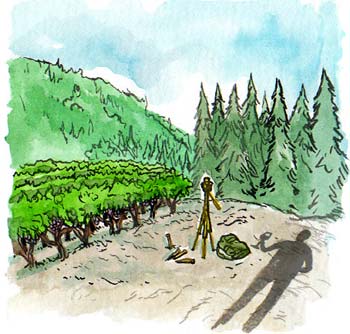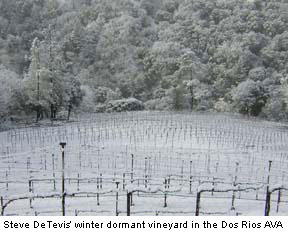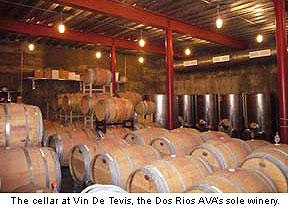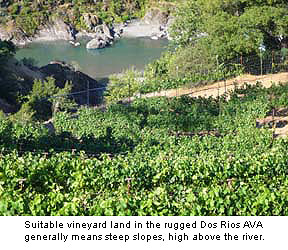

Northern Mendocino has two new AVAs,
but who is the man behind their creation?
The Mysterious Ralph Carter: AVA Petitioner-at-Large
by
Mark DeWolf
August 16, 2006
Mark DeWolf(MD): Ralph, what were the motivations to plant grapes in Covelo – a region that is by all accounts off the beaten track to say the least?
Ralph Carter(RC): My wife and I were looking for possible nursery and field crops to grow in Round Valley (located within the now recognized Covelo AVA) when she looked at a small vineyard and said it looked like a lot of fun, my studies began and I was hooked… We then built an experimental block of nine varieties of grapes with invigorating results.
MD: Planting vines in an undiscovered and out of the way region, must involve a lot trial and error. Please relate your experience?
RC: As the research and learning curve progressed over the years, more and more encouraging discoveries came about, mostly from comparative studies found in my personal wine library (and the resources of the Healdsburg and St. Helena Wine Libraries)…Theses studies have culminated with the assurance that dozens of very good quality varieties of grapes, both table and wine, exist that can suit the (Covelo) area’s cold winters, short growing period, summer temperatures of hot days / cool nights, pest pressures, soil situations, water conservation issues, erosion control concerns etc., while treading lightly on the land.
 MD: You obviously spent a lot of time researching the Covelo AVA. How does someone that has undertaken the laborious task of writing an AVA petition, end up writing two?
MD: You obviously spent a lot of time researching the Covelo AVA. How does someone that has undertaken the laborious task of writing an AVA petition, end up writing two?
RC: While writing the AVA proposal for Covelo, I had contact with Steve DeTevis of Vin De Tevis who expressed an interest in an AVA for Dos Rios also (10 miles from Covelo). As I researched the area, I became increasingly excited about Dos Rios as a viticulture area that really means something. The terroir is so consistent that the resulting juice would be too. To the best of my knowledge, I am the only AVA author to have provided this service free of charge. All other AVA authors have been financially connected with vineyards or wineries in the area or are commercial compliance services.
MD: Can you elaborate on your statement, “Dos Rios as a viticulture area that really means something.”?
RC: (An) important feature of this area is the regular afternoon summer winds that not only cool the vines but also cause closure of the leaf cells, giving a break in the otherwise impetuous ripening process characteristic of the surrounding warm inland areas, which have a reputation of "sitting and baking". The boundaries of the Dos Rios AVA have been framed around this wind gap to assure a certain degree of quality throughout. No two growers would be able to grow vastly different quality wine here as there are no flat, high fertility sites in the topography. Out of this 15,500 acre designated viticulture area only about 900 acres are suitable for planting. The rest of the area is too steep and prone to landslides or too near the river and subject to winter high water.
Grapes grown at this high elevation, fermented in small lots, in small barrels and handled with the care a small production vintner can give small lots is the epitome of fine wine making. This is especially impressive when you consider bargains such as the Vin de Tevis Pinot Noir made from organically grown, small berry vines ($8/bottle, 150 cases, just released) plus killer Cabernet Franc that is just now hitting its aging sweet spot.
I see many similarities of Covelo and Dos Rios to many of the world’s premier growing regions. The conditions in those two AVAs actually are better than many well known viticulture areas.
MD: Everything you write, clearly indicates a passion and respect for the land. Have you always been so concerned about the environment?
RC: When I was a child, my parents encouraged my natural interests in nature and earth science. They even provided me with my own science lab at home. I had many scientific collections including one of insects. I learned about pest species and predatory species, how pesticides are indiscriminate and how they upset the healthy natural balance. I have seen this natural predation in action. When my wife and I were raising the experimental block of grapes, we were concerned about an infestation of grasshoppers early in the season. About this same time a neighbor donated several loads of well rotted horse manure which we were composting. The manure was still attracting flies which attracted the fly catcher birds, who ate the flies. Their activity attracted the blackbirds which ate the grasshoppers. Two problems solved and we still had the lady bugs, praying mantis, spiders and other beneficial insects to protect the vines from aphids and other undesirable insects.
I think nurturing the soil is a lot like nurturing our bodies. A vitamin/mineral supplement may supply most of the major and even minor nutrients needed to sustain life, but optimal health comes from whole, real food. So it is with the soil, petrochemicals can supply nutrients and minerals, but the best soil is alive with micro-organisms that thrive with the addition of well composted vegetation and manure along with the rock dust and other natural nutrients added as needed. Stewardship of the land encompasses consideration and respect for not only the land but ourselves, our grandchildren and for other species as well.
MD: How does this apply to your own vineyard practices and the Covelo AVA as a whole?
RC: The Covelo area has a mission statement and goal to promote organic growing in the area. This dedication to organic growing, the premium prices awarded organically grown and processed wines, the encouragement toward responsible stewardship of the land and land that is relatively reasonably priced contribute to the potential for this area to create a unique product that is area specific and at the same time create a legacy for the future. The remote location combined with the almost total lack of services (most tourists require a certain critical mass of entertainment, resort lodges and fine dining etc.) should keep this area mostly unchanged. Historically wine growing areas more than 200 miles from major metropolitan areas do not get built up but retain their rural character. The approved AVA has proven the area's unique growing conditions and this helps give the identity to the area and the product! This identity assurance is passed on this way to the consumer.
MD: Will Covelo be recognized for a
Ralph Carter(RC): My wife and I were looking for possible nursery and field crops to grow in Round Valley (located within the now recognized Covelo AVA) when she looked at a small vineyard and said it looked like a lot of fun, my studies began and I was hooked… We then built an experimental block of nine varieties of grapes with invigorating results.
MD: Planting vines in an undiscovered and out of the way region, must involve a lot trial and error. Please relate your experience?
RC: As the research and learning curve progressed over the years, more and more encouraging discoveries came about, mostly from comparative studies found in my personal wine library (and the resources of the Healdsburg and St. Helena Wine Libraries)…Theses studies have culminated with the assurance that dozens of very good quality varieties of grapes, both table and wine, exist that can suit the (Covelo) area’s cold winters, short growing period, summer temperatures of hot days / cool nights, pest pressures, soil situations, water conservation issues, erosion control concerns etc., while treading lightly on the land.
 MD: You obviously spent a lot of time researching the Covelo AVA. How does someone that has undertaken the laborious task of writing an AVA petition, end up writing two?
MD: You obviously spent a lot of time researching the Covelo AVA. How does someone that has undertaken the laborious task of writing an AVA petition, end up writing two?RC: While writing the AVA proposal for Covelo, I had contact with Steve DeTevis of Vin De Tevis who expressed an interest in an AVA for Dos Rios also (10 miles from Covelo). As I researched the area, I became increasingly excited about Dos Rios as a viticulture area that really means something. The terroir is so consistent that the resulting juice would be too. To the best of my knowledge, I am the only AVA author to have provided this service free of charge. All other AVA authors have been financially connected with vineyards or wineries in the area or are commercial compliance services.
MD: Can you elaborate on your statement, “Dos Rios as a viticulture area that really means something.”?
RC: (An) important feature of this area is the regular afternoon summer winds that not only cool the vines but also cause closure of the leaf cells, giving a break in the otherwise impetuous ripening process characteristic of the surrounding warm inland areas, which have a reputation of "sitting and baking". The boundaries of the Dos Rios AVA have been framed around this wind gap to assure a certain degree of quality throughout. No two growers would be able to grow vastly different quality wine here as there are no flat, high fertility sites in the topography. Out of this 15,500 acre designated viticulture area only about 900 acres are suitable for planting. The rest of the area is too steep and prone to landslides or too near the river and subject to winter high water.

Grapes grown at this high elevation, fermented in small lots, in small barrels and handled with the care a small production vintner can give small lots is the epitome of fine wine making. This is especially impressive when you consider bargains such as the Vin de Tevis Pinot Noir made from organically grown, small berry vines ($8/bottle, 150 cases, just released) plus killer Cabernet Franc that is just now hitting its aging sweet spot.
I see many similarities of Covelo and Dos Rios to many of the world’s premier growing regions. The conditions in those two AVAs actually are better than many well known viticulture areas.
MD: Everything you write, clearly indicates a passion and respect for the land. Have you always been so concerned about the environment?
RC: When I was a child, my parents encouraged my natural interests in nature and earth science. They even provided me with my own science lab at home. I had many scientific collections including one of insects. I learned about pest species and predatory species, how pesticides are indiscriminate and how they upset the healthy natural balance. I have seen this natural predation in action. When my wife and I were raising the experimental block of grapes, we were concerned about an infestation of grasshoppers early in the season. About this same time a neighbor donated several loads of well rotted horse manure which we were composting. The manure was still attracting flies which attracted the fly catcher birds, who ate the flies. Their activity attracted the blackbirds which ate the grasshoppers. Two problems solved and we still had the lady bugs, praying mantis, spiders and other beneficial insects to protect the vines from aphids and other undesirable insects.

I think nurturing the soil is a lot like nurturing our bodies. A vitamin/mineral supplement may supply most of the major and even minor nutrients needed to sustain life, but optimal health comes from whole, real food. So it is with the soil, petrochemicals can supply nutrients and minerals, but the best soil is alive with micro-organisms that thrive with the addition of well composted vegetation and manure along with the rock dust and other natural nutrients added as needed. Stewardship of the land encompasses consideration and respect for not only the land but ourselves, our grandchildren and for other species as well.
MD: How does this apply to your own vineyard practices and the Covelo AVA as a whole?
RC: The Covelo area has a mission statement and goal to promote organic growing in the area. This dedication to organic growing, the premium prices awarded organically grown and processed wines, the encouragement toward responsible stewardship of the land and land that is relatively reasonably priced contribute to the potential for this area to create a unique product that is area specific and at the same time create a legacy for the future. The remote location combined with the almost total lack of services (most tourists require a certain critical mass of entertainment, resort lodges and fine dining etc.) should keep this area mostly unchanged. Historically wine growing areas more than 200 miles from major metropolitan areas do not get built up but retain their rural character. The approved AVA has proven the area's unique growing conditions and this helps give the identity to the area and the product! This identity assurance is passed on this way to the consumer.
MD: Will Covelo be recognized for a










 Appellation America is proud to feature the wines of
Appellation America is proud to feature the wines of 



